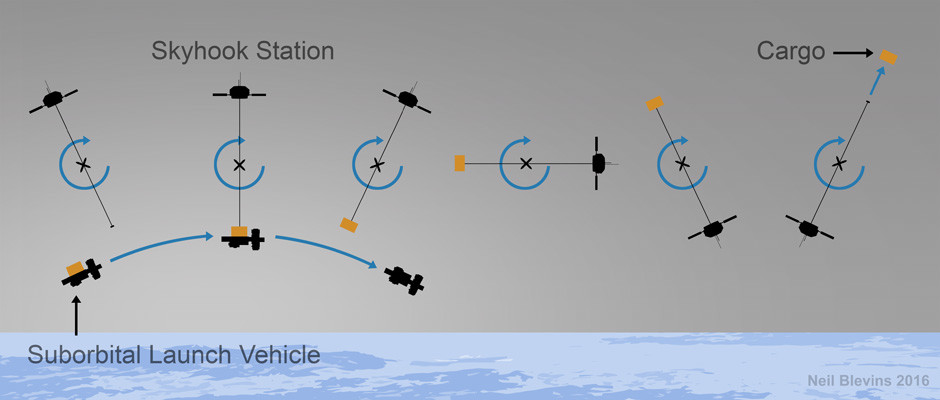The Skyhook
A skyhook is a proposed momentum exchange tether that aims to reduce the cost of placing payloads into low Earth orbit. A heavy orbiting station is connected to a cable which extends down towards the upper atmosphere. Payloads, which are much lighter than the station, are hooked to the end of the cable as it passes, and are then flung into orbit by rotation of the cable around the centre of mass. The station can then be reboosted to its original altitude by electromagnetic propulsion, rocket propulsion, or by deorbiting another object with the same kinetic energy as transferred to the payload.
A skyhook differs from a geostationary orbit space elevator in that a skyhook would be much shorter and would not come in contact with the surface of the Earth. A skyhook would require a suborbital launch vehicle to reach its lower end, while a space elevator would not.

Types of Skyhook
Non-rotating skyhook
A non-rotating skyhook is a vertical gravity-gradient stabilized tether whose lower endpoint appears to hang from the sky. It was this appearance that led to the adoption of the name skyhook for the construct.
Rotating skyhook
By rotating the tether around the orbiting center of mass in a direction opposite to the orbital motion, the speed of the hook relative to the ground can be reduced. This reduces the required strength of the tether, and makes coupling easier.
The rotation of the tether can be made to exactly match the orbital speed (around 7–8 km/s). In this configuration, the hook would trace out a path similar to a cardioid. From the point of view of the ground, the hook would appear to descend almost vertically, come to a halt, and then ascend again. This configuration minimises aerodynamic drag, and thus allows the hook to descend deep into the atmosphere. However, according to the HASTOL study, a skyhook of this kind in Earth orbit would require a very large counterweight, on the order of 1000–2000 times the mass of the payload, and the tether would need to be mechanically reeled in after collecting each payload in order to maintain synchronization between the tether rotation and its orbit.


